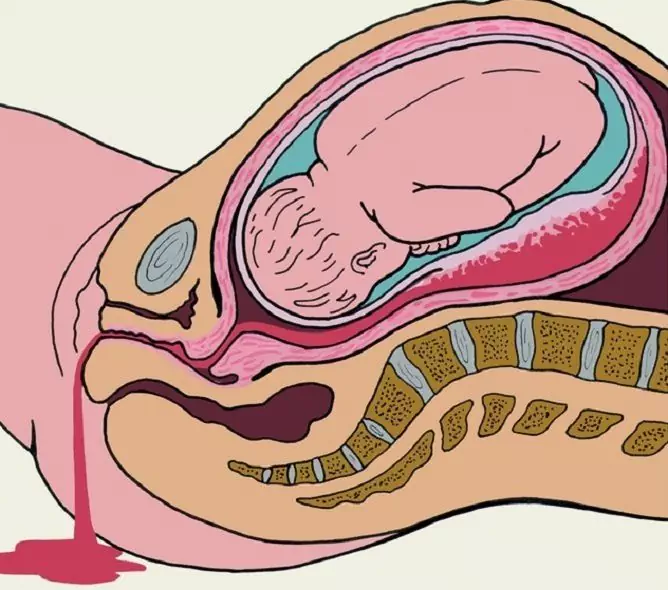- Author Rachel Wainwright [email protected].
- Public 2023-12-15 07:39.
- Last modified 2025-11-02 20:14.
Endocarditis
Brief description of the disease

Endocarditis is an inflammatory process that forms in the inner lining of the heart during infection, fungal diseases, sepsis, diffuse lesions of connective tissue, poisoning (uremia).
By origin, rheumatic and infectious, or septic endocarditis are distinguished.
Reasons for the appearance
Infective endocarditis most often occurs due to streptococci, coli and Pseudomonas aeruginosa, staphylococci, Proteus, and other pathological microorganisms.
There are also known cases of endocarditis due to congenital, acquired heart defects, after the installation of valve prostheses, but this happens quite rarely.
Rheumatic endocarditis develops as a complication of the existing rheumatism of the heart.
The risk of developing endocarditis also increases in those who have previously suffered from this disease, suffer from hypertrophic cardiomyopathy, have AIDS, are on hemodialysis, use drugs (provoking factor: manipulation of veins in aseptic conditions).
Endocarditis symptoms
Symptoms of endocarditis due to infection appear during the first 2 weeks after infection. Flu-like sensations are characteristic: fatigue and low temperature. More severe endocarditis symptoms may occur if infected with potent strains. It can be fever and chills, weight loss, joint pain, profuse sweating at night, shortness of breath and persistent cough, bleeding under the nails, petechiae (small red or purple spots on the skin).
If infective endocarditis has caused damage to the valves, symptoms of heart defects may develop, if the heart muscle is inflamed, arrhythmia, heart failure, and impaired conduction may occur. If blood vessels are involved in the inflammation, thrombosis, spleen or liver infarction begins, aneurysms, bruises on the skin may appear. Glomerulonephritis, enlarged liver, spleen, minor jaundice can also be found.
Symptoms of endocarditis, which has developed due to rheumatism: slight malaise, chills, fever, heart pain, shortness of breath, palpitations even with a slight load, increased heart rate, abnormally excited activity of the heart, displacement of its boundaries. When listening to the heart, systolic or diastolic murmurs are noted. The reaction of erythrocyte sedimentation is accelerated.
Complications that can develop after endocarditis: valve rupture, impaired renal function, heart disease. There is also a decrease in the level of leukocytes, hemoglobin, and ESR increases.
Diagnosis of the disease
Echocardiographic examination helps to diagnose - this is how valve damage, localization and extent of bacterial colonization are revealed. If endocarditis is infectious, blood cultures are done to identify the pathogen, determine the level of its sensitivity to antibacterial drugs.
Endocarditis treatment

Treatment of endocarditis consists in antibiotic therapy (in large doses), immunotherapy (antistaphylococcal gamma globulin and plasma are administered). The patient will also be prescribed immunomodulators (thymalin, T-activin), glucocorticosteroid hormones (for example, prednisolone), curaltil, aspirin, trental, heparin.
Also, a positive effect is provided by the treatment of endocarditis with ultraviolet blood irradiation, hemosorption, plasmapheresis.
For the treatment of septic endocarditis, sodium salt of benzylpenicillin in large doses or drugs from the penicillin group (methicillin, oxacillin), or cephalosporins, gentamicin can be prescribed.
If endocarditis is not eliminated by antibiotic therapy, surgery may be prescribed to remove and replace the affected valve.
Timely medical treatment allows to achieve a stable remission (in some cases by 3-5 years), but the patients remain disabled. Recurrences of septic endocarditis can cause severe valve damage and heart failure. There is a high probability of death in cases of complications of endocarditis by chronic renal failure.
Treatment of endocarditis caused by rheumatism is the same as for the underlying disease: salicylic sodium (aspirin, amidopyrine), butadione, indomethacin, prednisone or prednisone are prescribed. Penicillin may also be prescribed. The patient is shown fractional nutrition, limiting the amount of salt consumed, taking B vitamins.
Prevention of the disease
Infective endocarditis can only be prevented by effective treatment of infections and sepsis, especially in patients with acquired or congenital heart defects.
Prevention of rheumatic endocarditis consists in the prevention of rheumatism and its timely and correct treatment, maintenance of immunity.
YouTube video related to the article:
The information is generalized and provided for informational purposes only. At the first sign of illness, see your doctor. Self-medication is hazardous to health!






